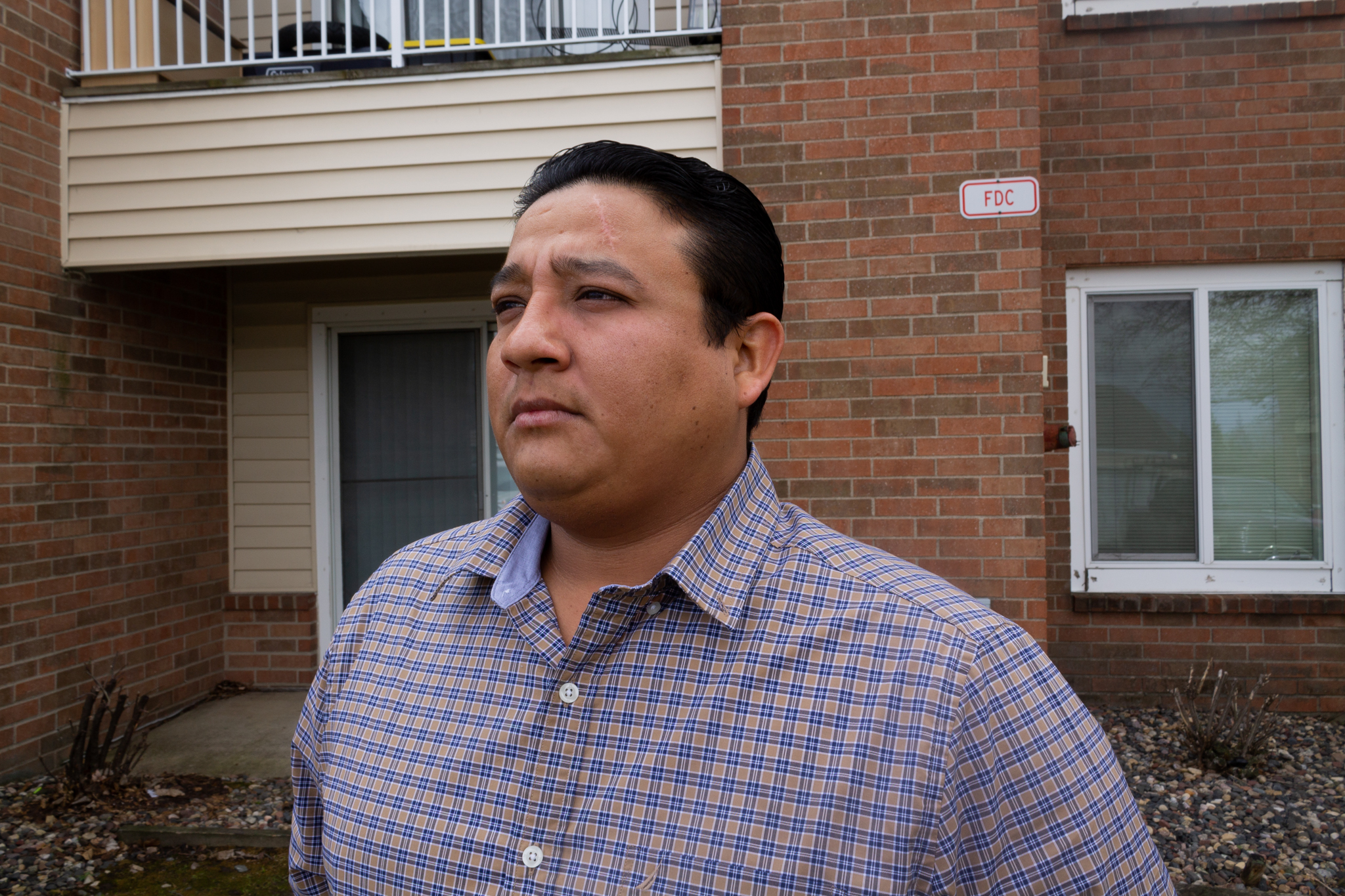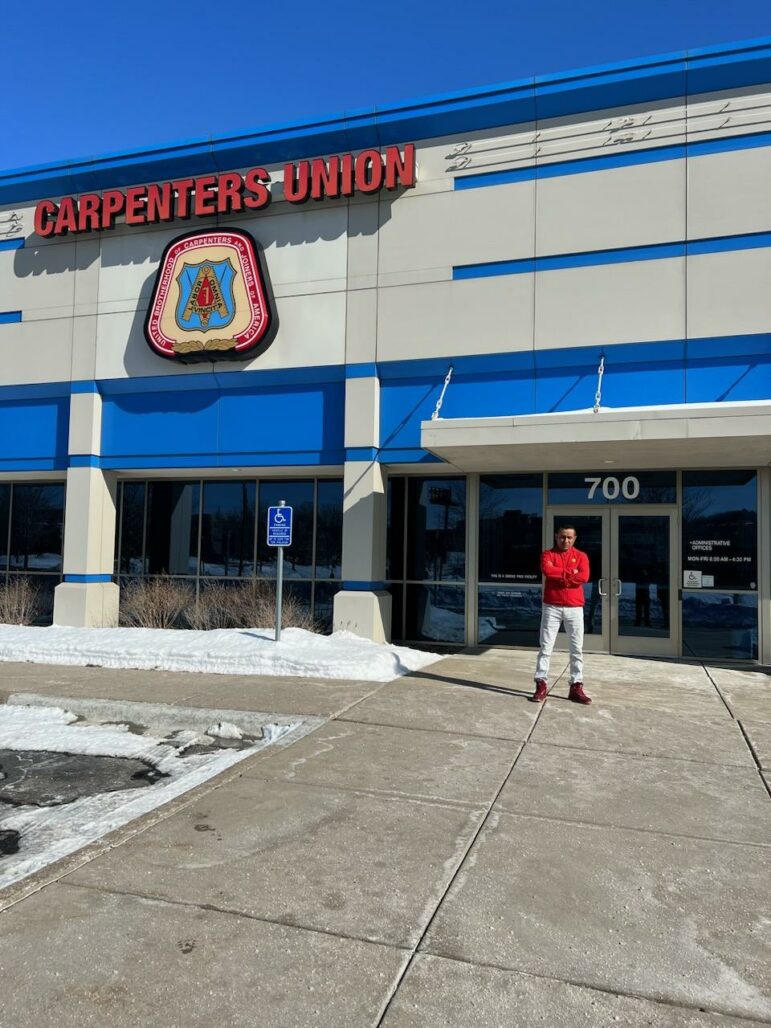
José Alfredo Gómez standing in front of his home. He has a large scar on his forehead from falling two stories while working on a construction site.

Share
In 2022, construction worker José Alfredo Gómez fell two stories from the home he was working on, he says. A group of men on a boat in a nearby lake saw and called an ambulance. This was against the wishes of the jobsite supervisor, who insisted on transporting him in a work van, which had no seats and was filled with tools, Gómez says. The ambulance arrived, but Gómez’s injuries were so extreme, emergency personnel decided it would be best to airlift him to a hospital in St. Paul, Minn., where he was able to be treated, he recalls.
Gómez, who declines to name the company he was working for at the time, says he suffered from two fractured elbows, a broken hip, a large laceration on his forehead, and head trauma. “Imagine, the bone had come out of my pelvis,” he says. “The bone was sticking out.”
When he was recovering in the hospital, he says he received a visit from his boss, who assured him there was no need to contact lawyers. Around a month later, his boss offered him a weekly payment of $200 and advised him to change his address and work under a different name to avoid paying the medical bills, according to Gómez.
Then the first few medical bills arrived, he says, totaling tens of thousands of dollars. Gómez explains that in that moment he realized he needed support. A friend and fellow construction worker referred him to Centro de Trabajadores Unidos en Lucha (CTUL), a workers’ center, which educated him of his rights and connected him with a lawyer.
According to Gómez, this lawyer helped him see that he was not covered under the company’s insurance policy, even though he was, by all intents and purposes, an employee. He was deprived of this coverage due to a prevalent—yet poorly understood—mechanism: denying Gómez’s rights to workers’ compensation as a direct employee, instead leaving him on the hook for providing his own care, a responsibility that independent contractors have. This essentially amounts to misclassification, which can occur intentionally, or due to lack of understanding of the law. Whatever the intent, Gómez suffered as a result.

Isabela Escalona
José Alfredo Gómez with his wife and two children.Misclassification is the practice of identifying workers as independent contractors when, in reality, they act as employees of the company, often in order for the employer to avoid paying the worker benefits, overtime, taxes, and insurance—and to avoid responsibility when accidents occur on jobsites. Misclassification often goes hand in hand with wage theft, and is especially common in the non-union sector of the construction industry.
An independent contractor is someone who is self-employed and therefore subject to self-employment tax. In contrast to a standard employee, the entity that hires an independent contractor may not control how or when work is done, but only has influence over the result of that work. Construction workers who are employees of a company are entitled to certain protections, like workers’ compensation if they are injured on the job, whereas independent contractors are not eligible, unless they provide their own insurance. By underreporting the amount of employees working for them, companies can save on insurance costs or pass off the expense to the employee if an injury does occur.
According to a 2021 report by the Midwest Economic Policy Institute and the Illinois Economic Policy Institute, around 30,100 construction workers in Minnesota “are misclassified or are paid off the books, accounting for 23 percent of the workforce.” Misclassification doesn’t just harm the workers themselves, but the public as a whole: “Minnesota annually loses $136 million in state tax revenues due to construction payroll fraud,” the report says.
This may seem like a clerical error, or run-of-the-mill cutting corners. But misclassification of workers can lead to dangerous outcomes, including delayed treatment for workplace injuries, and financial hardship from medical bills.
Once Gómez’s lawyer contacted the company, his employer finally agreed that he was, in fact, an employee who is covered by the company’s workers’ compensation insurance. But it is possible, had he not had an advocate, the outcome could have been very different.
Today, Gómez is recovering at home in Eagan, Minn. with his wife and two daughters. He has pins in his elbows, walks with a slight limp, and has a large scar across the side of his forehead. He shows off his most recent hospital bill, pointing out the line that shows his employer’s workers’ compensation insurance is covering the exorbitant expense. He says he is grateful and relieved, as a hospital bill of that amount would have left his family bankrupt.
But even with the correction in his classification, he faces tremendous hardship. The accident caused significant financial strain, forcing his wife to quit her job because he required constant, daily care, from bathing to changing his clothes. He described his condition after those first few months after the accident as that of “a newborn baby.” Gómez explains, “I want to share this experience with you, not with the intention of seeking pity, but rather to raise my voice for those who are going through this situation.”
Gómez, now a board member of CTUL, says there is much at stake in the fight to stop misclassification. “Those who suffer are our families, and I would like this message to reach those developers to put their hand on their heart and realize that they are not only harming the worker, but they are also harming the whole family.”
Compounding dangers
The human impact is apparent in the criminal case against Nelson Israel Lopez Giron, of Giron Construction LLC, a subcontractor for some of the most prominent developers in the Twin Cities. The complaint, filed by the state of Minnesota in April 2023, charged Giron with insurance fraud. The case was brought to light by the North Central States Regional Council of Carpenters, which represents nearly 27,000 union members in Minnesota, Iowa, Nebraska, North Dakota, South Dakota, and Wisconsin.
According to the complaint, in an application for workers’ compensation insurance, Giron Construction, which is based in Eden Prairie, Minn., reported that its employee payroll was $0, indicating that it had no standard employees. However, things took a turn on February 6, 2020, when a construction worker, referred to as ‘Witness 1’ in the complaint, was allegedly severely injured on a Giron Construction jobsite in Minnetonka, Minn. A nail ricocheted off a surface and struck the worker in the eye, and advocates from CTUL say this caused nerve damage.
According to the complaint, the defendant did not report the injury to workers’ compensation insurance as required by law, “but instead gave Witness 1 some eye drops.” When the worker finally decided to seek professional treatment, Giron allegedly encouraged the worker to lie to healthcare professionals “about how the injury occurred.” The worker obliged, according to the complaint, and told the hospital staff that he had fallen on ice. The defendant later allegedly offered to make a payment directly to the worker. When the worker applied for coverage under the employer’s workers’ compensation insurance, he was initially denied because Giron allegedly claimed he did not know the worker, the complaint states.
The complaint accuses Giron of misleading insurance agents and misrepresenting his payroll costs, and ultimately pocketed $19,000 through the misclassification scheme. According to the complaint, Witness 1 “later told investigators that Defendant was his boss, paid him hourly, and provided many of his tools. He said that there were upwards of 13 to 15 workers on the jobsite every day.”
On May 17, the prosecution offered a plea deal to Giron, but it has not yet been agreed and the case is still ongoing, with a pre-trial hearing scheduled for June 26.
However, with an estimate of 23% of the workforce subject to misclassification, many workers and advocates claim that there must be a more proactive solution than waiting for individual cases to be addressed through the legal system.
The crime being prosecuted in the Giron Construction case, after all, is not the delaying and interference of medical treatment of a worker who suffered injury to his eye. The crime being prosecuted is insurance fraud. Critics say that the legal system does not account for the true human suffering in one of the most dangerous industries for workers in the country.
Threats and intimidation
In May 2022, the Minnesota Reformer reported that the Minnesota Department of Labor launched a wage theft investigation on behalf of workers on the Viking Lakes project, a practice facility for the Minnesota Vikings football team in Eagan, Minn., with adjacent luxury apartments. The developer of this project is MV Ventures, a real estate developer owned by the billionaire Wilf family, which owns the Minnesota Vikings, and worked with a number of contractors on the project.
In October, Attorney General Keith Ellison announced that his office filed a lawsuit against “Leo Pimentel and his companies, Property Maintenance & Construction LLC and Property Maintenance & Construction Inc. (PMC),” for allegedly obstructing this investigation. (PMC was among the companies initially probed.) “PMC’s obstruction has taken the form of actively dissuading workers from cooperating with DLI, failing to keep appropriate employment records, and refusing to provide DLI with the records it does have, despite its legal obligation to do so,” states a press release from Ellison’s office.
Francisco Lozano, a 38-year-old construction worker and member of the North Central States Regional Council of Carpenters, worked for PMC beginning in 2020, where he was doing siding work on the Viking Lakes project.
Lozano says he was paid in cash by PMC and tasked to pay out the crew he worked with. He was under the impression that he and his crew were working as employees, but says he was encouraged by a supervisor to start his own company with false documents. However, Lozano says he was not receiving enough cash to pay his crew adequate wages for the amount of hours they worked, and none of them received employee benefits or overtime pay. After confronting his supervisor at PMC, Lozano says he was told that he did not understand the way things worked and that he should mind his own business.
Lozano stopped working for PMC in early 2021 and decided to work on other projects, he says,. Shortly after, he says he received a threatening text message from his boss. Additionally, the boss allegedly told him that they would spread rumors about him that he was a bad worker and stole company tools so that he would not be able to find work in the construction industry, threatening his livelihood. Lozano says he also received threatening phone calls from the boss and members of the boss’s family who would threaten him if he ever spoke to the Department of Labor or the IRS, and an organizer with the Regional Council confirmed to Workday Magazine that he had witnessed one such call. Lozano’s key concerns broadly align with those of other construction workers who have come forward with allegations of threats and intimidation from the company.
PMC did not respond to a detailed request for comment, but has previously denied similar allegations.
Lozano says the experience left him feeling “powerless,” and led to a “painful” few years where he was unable to provide for his children in the way he wanted amid the stress of dealing with threats of possible violence if he came forward.
Lozano did not speak out for a year and a half because he was afraid of retaliation against him, his wife, and two children, he says. In 2022, he spoke with representatives of the Regional Council. He described the conversation in an interview with Workday Magazine as having a domino effect; he realized he was in the same situation as about 40 other workers on the Viking Lakes project, employed by PMC alongside other companies, coming forward with similar stories of threats, wage theft, misclassification, and, in the case of Absolute Drywall, even alleged rape and sexual assault. However, Lozano says that he has many construction worker friends who faced similar threats and to this day refuse to come forward with their stories, fearing retaliation.

Jorge Duran
Francisco Lozano standing in front of the Carpenters Union hall in St. Paul, Minn.Lozano’s experience is common for non-unionized workers in the construction industry—where misclassification can be a harbinger of other workers’ rights abuses. Misclassification of workers on the surface may seem like a victimless crime. However, its ripple effects of wage theft, delayed medical treatment, and the use of threats and intimidation to maintain compliance cause real human suffering.
While there were several subcontractors facing legal action stemming from the Viking Lakes project, including PMC and Absolute Drywall, the severity and scale of the case is calling into question the accountability structure of the developer, MV Ventures, and other developers at the top of the chain on these types of projects.
Holding the top of the ladder accountable
Among the many labor protections passed in the 2023 Minnesota legislative session is a bill that holds general contractors “civilly liable” for wage theft violations committed by subcontractors they hire on a jobsite. This legislation, titled Construction Worker Wage Protection Act (HF1859), could shift the legal accountability structure to deter developers from working with contractors with histories of worker rights violations like misclassification and wage theft.
The bill faced significant pushback from general contractors and their associations, and developers have hinted they may take legal action against it. But similar laws across the country, from New York to California to Virginia, have withstood such attacks.
Misclassification is one reason wage theft is so common in the non-union construction industry. Although Minnesota already has one of the strongest wage theft protection bills in the country, worker advocates say that the bill is not sufficiently enforced, cannot keep up with the scale of the problem, and does not hold the industry’s power players accountable—specifically the developers and general contractors.
In a summary of the 2023 Minnesota legislative session, the Regional Council called the Act “an extension of our work on wage theft with a design to deter generals from hiring unscrupulous sub-contractors”.
Merle Payne, co-director of CTUL, praises the legislation and describes it as a step forward for addressing wage theft in the industry. But, Payne says, legislation could go even further, by prioritizing accountability with the developers at the top of the chain, rather than just the general contractor. “These players decide how much can and will be spent on construction projects,” he says, yet they are too often shielded from accountability. “Until this changes, we will not see an end to wage theft in the industry.”
On the federal level, a recent ruling from the National Labor Relations Board, and a proposed rule from the Department of Labor, could end up protecting more workers from misclassification.
CTUL, meanwhile, is building a local solution that is led by workers themselves. The organization is throwing its weight behind a different proposal, titled the Building Dignity and Respect Standards Council (BDC), which was co-developed by the Worker-Driven Social Responsibility Network and supported by the Regional Council. This model allows developers to agree to a code of conduct going all the way down to contractors and subcontractors, and includes mechanisms for enforcement, led by workers. These mechanisms include: monitoring, support, and assistance to help contractors follow standards—and take action if they don’t. This kind of worker-driven social justice model has been implemented successfully in other industries and locations, for example, farm workers in Immokalee, Fla.
Advocates say the BDC program is “designed to encourage and support fair and dignified workplaces characterized by mutual respect, open communication, and efficient conflict resolution.” They hope, too, that it would help reduce the problem of misclassification.
Construction isn’t the only industry facing misclassification—and the collateral damage that comes with it. According to a report published in 2023 by the Economic Policy Institute, other industries with high misclassification rates include landscapers, truck drivers, home health aides, janitors, and nail salon workers. The report states that a typical construction worker misclassified as an independent contractor “would lose out on as much as $16,729 per year in income and job benefits compared with what they would have earned as an employee.”
Misclassification of workers as independent contractors not only hurts the workers and their families—it also creates a massive deficit towards state and federal tax revenue. In a report by the National Employment Law Project in 2020, researchers found that if “state reports show that 10 to 30 percent of employers (or more) misclassify their employees as independent contractors,” that would lead to “[state] and federal governments [losing] billions in revenues annually.”
Gómez says the BDC program would ensure that the entire chain of command is accountable to the workers: “The entire line of contractors has the same responsibility to respond to the worker. Because the worker is generating profit for the whole line of contractors.”
“You have to take care of the working hand, because that is where everything comes from.”
This article was updated on August 21 to correct details about Jose Alfredo Gómez’s personal story.

